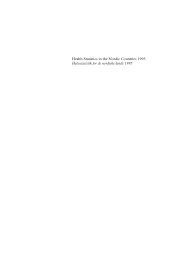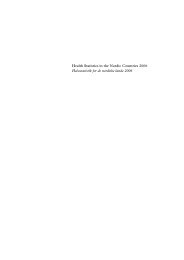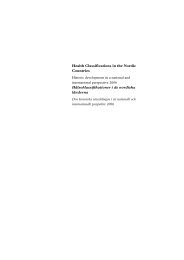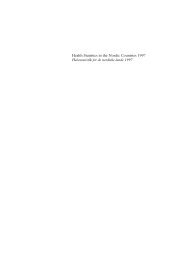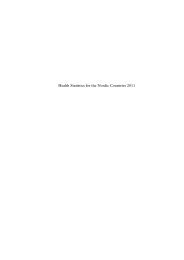Icke-inlagda patienter” - nomesco
Icke-inlagda patienter” - nomesco
Icke-inlagda patienter” - nomesco
Create successful ePaper yourself
Turn your PDF publications into a flip-book with our unique Google optimized e-Paper software.
Ca re for elderly people in<br />
the Nordic countries Today, elderly people are much healt hier<br />
than in the past , but since the proportion of el derly people aged over 80 is increasing,<br />
the need for trea tment and care and<br />
the cost of providing these services for<br />
elderly people are also increasing. THE HEALTH OF ELDERLY PEOPLE<br />
Äldreomsorgen i de<br />
nordiska länderna De äldre är idag be tydligt frisk are än ti-<br />
digare, men i och m ed att andelen äldre<br />
över 80 år ökar så ökar k raven på och<br />
kostnaderna för vård och omsorg.<br />
In th e Nordic welfare sy stems,<br />
treat- I de nord iska välfärdssystemen så har<br />
men t and care services for elderly peo<br />
vården och omsorgen om de äldre, med<br />
ple are mainly public services that are en offentligt finansierad och till stor<br />
del<br />
publically funded.<br />
This has been one of offentligt producerad äldreomsorg ut-<br />
the cornerstones<br />
of the Nordic welfare<br />
gjort en av hörnstenarna i den nordiska<br />
model for a long time. The well- välfärdsmodellen under lång tid. Den<br />
developed services for children and eld- väl utbyggda barn- och äldreomsorgen i<br />
erly people in the Nordic countries has de nordiska länderna har möjliggjort för<br />
made it possible for relatives, and pri- anhöriga och då framför allt för dött-<br />
marily daughters, to work outside the rarna att arbeta utanför hemmet vilket<br />
home. This is one of the reasons why starkt bidragit till de nordiska kvinnor-<br />
Nordic women have a high income. nas höga förvärvsfrekvens.<br />
The latest statistics published by<br />
NOSOS-CO [35], show that the proportion<br />
of elderly people who live in institutions<br />
(old people’s homes, nursing<br />
homes) or other residences for people<br />
aged 65/67 and over, is highest in Norway:<br />
11.7 per cent. The proportion in<br />
Finland is only 6.9 per cent.<br />
Almost 25 per cent of people aged 80<br />
and older live in institutions in Norway<br />
and Iceland, but only 16.5 per cent in<br />
Sweden.<br />
In Sweden, home help services were introduced<br />
as early as in the 1950s, but<br />
they are available in all the Nordic countries<br />
now. The amount of service pro-<br />
vided is based on individual needs, and<br />
varies from a few hours per<br />
month to<br />
I Nososkos [35]senaste publicerade<br />
statistik visas att boende på institution<br />
(åldersdomshem, sjukhem) eller annat<br />
äldreboende för åldersgrupperna<br />
65/67 år och äldre är vanligast i Norge<br />
med 11,7 procent, medan i Finland<br />
endast 6,9 procent bor på institution.<br />
När det gäller gruppen 80 år och äldre<br />
bor nära 25 procent på institution<br />
både i Norge och på Island men endast<br />
16,5 procent i Sverige.<br />
I Sverige infördes hemhjälp redan på<br />
1950-talet, men det förekommer nu i<br />
alla de nordiska länderna. Omfattningen<br />
bestäms utifrån individuella behov<br />
och varierar från några timmar i månaden<br />
till flera timmar per dag. Målet<br />
341



